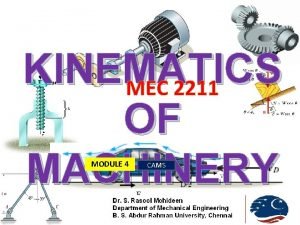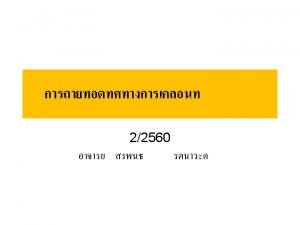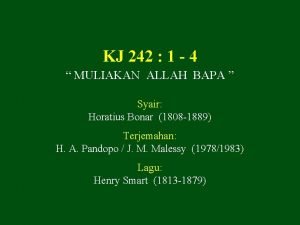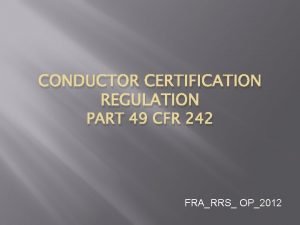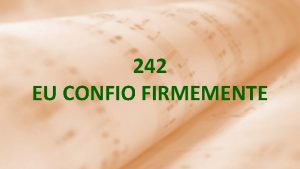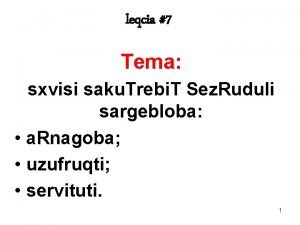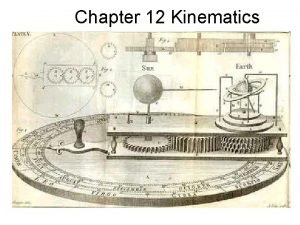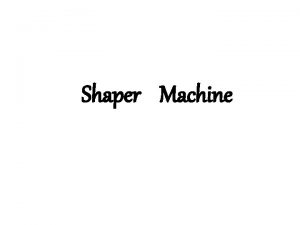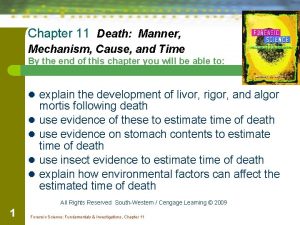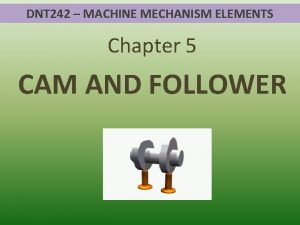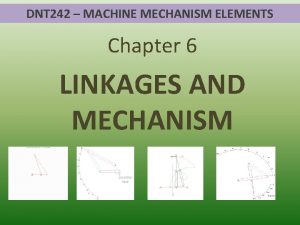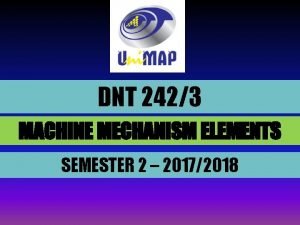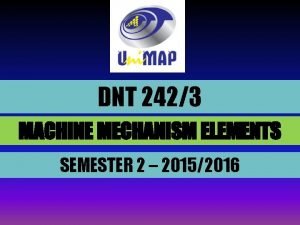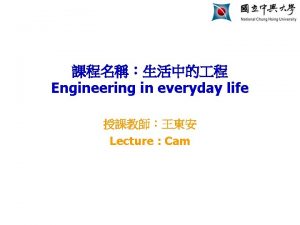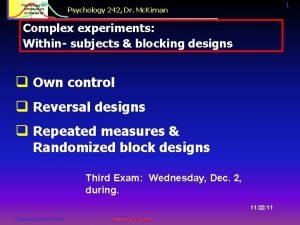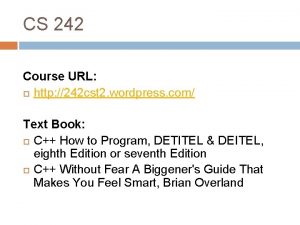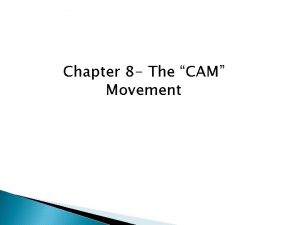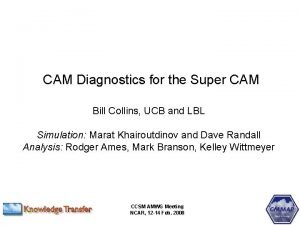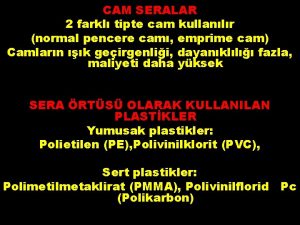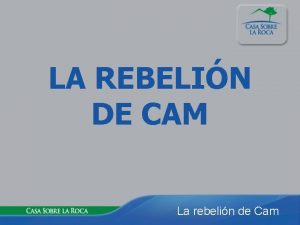DNT 242 MACHINE MECHANISM ELEMENTS Chapter 5 CAM









































- Slides: 41

DNT 242 – MACHINE MECHANISM ELEMENTS Chapter 5 CAM AND FOLLOWER

DNT 242 – MACHINE MECHANISM ELEMENTS v Brief introduction about basic of camshaft and follower. v Discuss the configuration and arrangement of camshaft and follower. v Define base circle, prime circle, pitch curve and other nomenclature. v Calculate velocity and acceleration motion. v Perform design of camshaft and follower base on the movement types.

Chapter 5: CAM AND FOLLOWER INTRODUCTION q A cam is a mechanical element used to drive another element, a follower, through a specified motion by direct contact. q A cam system consists of the cam itself and the follower, which moves through a guide and provides the output motion. q A cam and follower system is a system/mechanism that uses a cam and follower to create a specific motion.

Chapter 5: CAM AND FOLLOWER INTRODUCTION • A cam converts a rotary input motion into either reciprocating or oscillatory output action.

Chapter 5: CAM AND FOLLOWER INTRODUCTION • The cam has a very important function in the operation of many classes of machines, especially those of the automatic type, such as printing presses, shoe machinery, textile machinery, gear-cutting machines, and screw machines.

Chapter 5: CAM AND FOLLOWER Classification of Cam Mechanisms • Cam mechanisms can be classified by: q modes of input/output motion. q the type of the follower. q the arrangement of the follower. q the shape of the cam.

Chapter 5: CAM AND FOLLOWER 1. Modes of input/output motion.

Chapter 5: CAM AND FOLLOWER 1. Modes of input/output motion. Rotating cam – oscillating follower

Chapter 5: CAM AND FOLLOWER 1. Modes of input/output motion. Rotating cam – Translating follower

Chapter 5: CAM AND FOLLOWER 1. Modes of input/output motion. Translating Cam-translating follower

Chapter 5: CAM AND FOLLOWER 2. The type of the follower

Chapter 5: CAM AND FOLLOWER 2. The type of the follower Flat faced follower

Chapter 5: CAM AND FOLLOWER 2. The type of the follower

Chapter 5: CAM AND FOLLOWER 3. The arrangement of the follower

Chapter 5: CAM AND FOLLOWER 4. The shape of the cam

Chapter 5: CAM AND FOLLOWER 4. The shape of the cam

Chapter 5: CAM AND FOLLOWER Cam Nomenclature

Chapter 5: CAM AND FOLLOWER Cam Nomenclature

Chapter 5: CAM AND FOLLOWER Cam Nomenclature

Chapter 5: CAM AND FOLLOWER Design of Cam Systems

Chapter 5: CAM AND FOLLOWER Design of Cam Systems

Chapter 5: CAM AND FOLLOWER Design of Cam Systems • As the cam rotates the follower moves upward and downward. • The upward movement of follower is called rise (Outstroke) • The downward movement is called fall (Returnstroke). • When the follower is not moving upward and downward even when the cam rotates, it is called dwell.

Chapter 5: CAM AND FOLLOWER Design of Cam Systems

Chapter 5: CAM AND FOLLOWER Design of Cam Systems

Chapter 5: CAM AND FOLLOWER Design of Cam Systems

Chapter 5: CAM AND FOLLOWER Design of Cam Systems

Chapter 5: CAM AND FOLLOWER Design of Cam Systems

Chapter 5: CAM AND FOLLOWER Design of Cam Systems

Chapter 5: CAM AND FOLLOWER Design of Cam Systems

Chapter 5: CAM AND FOLLOWER Design of Cam Systems

Chapter 5: CAM AND FOLLOWER Design of Cam Systems

Chapter 5: CAM AND FOLLOWER Design of Cam Systems

Chapter 5: CAM AND FOLLOWER Design of Cam Systems

Chapter 5: CAM AND FOLLOWER Design of Cam Systems

Chapter 5: CAM AND FOLLOWER EXAMPLE #1

Chapter 5: CAM AND FOLLOWER EXAMPLE #1

Chapter 5: CAM AND FOLLOWER EXAMPLE #2 Follower type = Knife Edge, in line, follower rises by 50 mm with SHM in 120° of cam rotation, dwells for 60° of cam rotation, return with SHM in 90° of cam rotation and dwells during the remaining period. Base circle radius = 50 mm.

Chapter 5: CAM AND FOLLOWER EXAMPLE #2 Follower type = Knife Edge, in line, follower rises by 50 mm with SHM in 120 of cam rotation, dwells for 60 of cam rotation, return with SHM in 90 of cam rotation and dwells during the remaining period. Base circle radius = 50 mm.

Chapter 5: CAM AND FOLLOWER EXAMPLE #2

Chapter 5: CAM AND FOLLOWER QUIZ #2 Follower type = Knife Edge, in line, follower rises by 30 mm with SHM in 90° of cam rotation, dwells for 45° of cam rotation, return with SHM in 180° of cam rotation. It then dwells during the remaining period. Base circle radius = 35 mm.

THANK YOU
 Dnt machine
Dnt machine Cam cam. cc
Cam cam. cc External estop requested
External estop requested A radial follower is one
A radial follower is one Cam 2 cam chat
Cam 2 cam chat Dnt frivillig arbeid
Dnt frivillig arbeid 1st angle projection
1st angle projection Dnt travsport
Dnt travsport Dnt computer
Dnt computer Example of cam and follower
Example of cam and follower Types of mechanical toys
Types of mechanical toys Lagu muliakan allah bapa
Lagu muliakan allah bapa Gezang 242
Gezang 242 49 cfr 242
49 cfr 242 Eu confio firmemente
Eu confio firmemente Carrsh
Carrsh Csc 242
Csc 242 Ac network theorems
Ac network theorems Algol family
Algol family Vip room standard life
Vip room standard life Sxvisi
Sxvisi Step ap 242
Step ap 242 Et 242
Et 242 Schema 242
Schema 242 Hibbeler
Hibbeler I^242
I^242 Is-242.b
Is-242.b Fpunity
Fpunity Which is a reciprocating member of the shaper
Which is a reciprocating member of the shaper Cricket bowling machine mechanism
Cricket bowling machine mechanism Finite state machine vending machine example
Finite state machine vending machine example Moore machine and mealy machine
Moore machine and mealy machine Mealy to moore conversion
Mealy to moore conversion Chapter 10 energy, work and simple machines answer key
Chapter 10 energy, work and simple machines answer key Machine elements in mechanical design 5th edition
Machine elements in mechanical design 5th edition Characteristics of good instruction format
Characteristics of good instruction format J hanger bearing assembly drawing
J hanger bearing assembly drawing Machine elements in mechanical design
Machine elements in mechanical design Chapter 11 death meaning manner mechanism
Chapter 11 death meaning manner mechanism What are the elements of drama
What are the elements of drama Oracle landed cost management
Oracle landed cost management Atomic elements vs molecular elements
Atomic elements vs molecular elements



